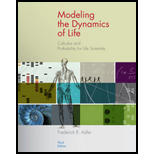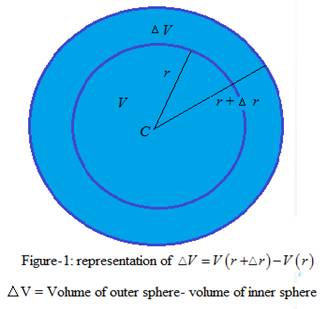
To find:The derivative of given function, to show change in the value of function with geometrical diagram, to give geometrical interpretation geometrically, and tell if unit makes sense.
Answer to Problem 30E
The derivative of volume with respect to radius is dVdr=4πr2 .
Explanation of Solution
Given information:
The volume of a sphere as a function of radius r is given by V(r)=4π3r3 . We have to find derivative of volume with respect to radius and show change in volume △V=V(r+△r)−V(r) with geometrical diagram, to give geometrical interpretation of the derivative, and to tell if units make sense.
Method/Formulaused:
The derivative of the function y=Cxn , C constant is dydx=Cnxn−1 .
Calculations:
The volumeof sphere of radiusris given by
V(r)=4π3r3 ... (1)
Differentiating equation (1) with respect to ‘ r’ , we have
dVdr=4π3×3r2=4πr2 ... (2)
The derivative of volume gives the change in volume of a sphere relative to the radius.
Let initially the radius of a sphere is r and changed to r+△r , then change in volume is
△V=V(r+△r)−V(r) ... (3)
⇒△V=4π3(r+△r)3−4π3(r)3=4π3[(r+△r)3−(r)3]
⇒△V=4π3[r3+(△r)3+3r△r(r+△r)−r3]=4π3[(△r)3+3r2△r+3r(△r)2]
Thus, V(r+△r)−V(r)=4π3[(△r)3+3r2△r+3r(△r)2] .
Now, V(r+△r)−V(r)△r=4π3[(△r)2+3r2+3r(△r)]
Since (△r)2 is very small quantity so can be neglected, therefore,
Let we write V(r+△r)−V(r)△r=△V△r
lim△r→0△V△r=lim△r→04π3[(△r)2+3r2+3r(△r)]
⇒lim△r→0△V△r=4π33r2=4πr2
⇒dVdr=4πr2∵lim△r→0△V△r=dVdr .
The change in volume of sphere with radiusis geometrically shown in Figure-1 here,

Interpretation of derivative geometrically:
It is given that the volume of sphere is a function of its radius. The graph of Vasthe function r is shown in Figure-2.
We consider two points P(r,V) and Q(r+△r,V+△V) . Clearly line PQ is secant and it will become a tangent when Q→P⇒△r→0 .
Let ∠QPN=θ , then from Figure-2, tanθ=QNPN=△V△r .
Now the secant PQ becomes tangent,then taking limit as △r→0 , we have lim△r→0tanθ=lim△r→0△V△r
⇒tanθ=dVdr . But tanθ is the slope of tangent to the curve at point P.
Thus, the derivative of V with respect to radius r represents the slope of the tangent line at a point of the curve,

The unit of △V is the as that of volume V and the unit of △r is same as that of radius r therefore the unit of the derivative is unit of volume divided by the unit of radius.
Conclusion:
The derivative of volume with respect to radius is dVdr=4πr2 .
Want to see more full solutions like this?
Chapter 2 Solutions
Modeling the Dynamics of Life: Calculus and Probability for Life Scientists
- Q4. Considering the following two normal distributions A and B, which statement (or statements) is correct? a) Mode of the distribution A is larger than that of distribution B. b) SD of the distribution B is larger than that of distribution A. c) Mean of the distribution A is smaller than that of distribution B. d) A data item with z-score of -1 falls between 20 to 30 in distribution A. e) A data item with z-score of +1 falls between 10 to 20 in distribution B. A 0 10 20 30 40 40 50 60 00 10 70 B 80 90 100arrow_forwardQ1. A traffic camera recorded number of red cars going through the intersection at 16th Ave N and Centre St. each day over 7 days was: 32 30 24 30 36 38 27 a) Calculate the mean, mode, range and median of the data set above. c) Calculate the standard deviation of this data set. Sarrow_forwardQ2. Government of Canada is designing Registered Retirement Saving Plans (RRSP) for Canadians. According to statistics Canada, the life expectancy in Canada is 86 years with standard deviation of 4.8 years. a) Find the z-score of a person who is 90 years old? b) Find the age of a person whose z-score is -1.4? c) What percent of people age higher than 80? d) What percent of people age less than 83? e) What percent of people age between 85 and 88?arrow_forward
- b pleasearrow_forward(b) Let I[y] be a functional of y(x) defined by [[y] = √(x²y' + 2xyy' + 2xy + y²) dr, subject to boundary conditions y(0) = 0, y(1) = 1. State the Euler-Lagrange equation for finding extreme values of I [y] for this prob- lem. Explain why the function y(x) = x is an extremal, and for this function, show that I = 2. Without doing further calculations, give the values of I for the functions y(x) = x² and y(x) = x³.arrow_forwardPlease use mathematical induction to prove thisarrow_forward
- L sin 2x (1+ cos 3x) dx 59arrow_forwardConvert 101101₂ to base 10arrow_forwardDefinition: A topology on a set X is a collection T of subsets of X having the following properties. (1) Both the empty set and X itself are elements of T. (2) The union of an arbitrary collection of elements of T is an element of T. (3) The intersection of a finite number of elements of T is an element of T. A set X with a specified topology T is called a topological space. The subsets of X that are members of are called the open sets of the topological space.arrow_forward
- 2) Prove that for all integers n > 1. dn 1 (2n)! 1 = dxn 1 - Ꮖ 4 n! (1-x)+/arrow_forwardDefinition: A topology on a set X is a collection T of subsets of X having the following properties. (1) Both the empty set and X itself are elements of T. (2) The union of an arbitrary collection of elements of T is an element of T. (3) The intersection of a finite number of elements of T is an element of T. A set X with a specified topology T is called a topological space. The subsets of X that are members of are called the open sets of the topological space.arrow_forwardDefinition: A topology on a set X is a collection T of subsets of X having the following properties. (1) Both the empty set and X itself are elements of T. (2) The union of an arbitrary collection of elements of T is an element of T. (3) The intersection of a finite number of elements of T is an element of T. A set X with a specified topology T is called a topological space. The subsets of X that are members of are called the open sets of the topological space.arrow_forward
- Algebra & Trigonometry with Analytic GeometryAlgebraISBN:9781133382119Author:SwokowskiPublisher:Cengage
 Big Ideas Math A Bridge To Success Algebra 1: Stu...AlgebraISBN:9781680331141Author:HOUGHTON MIFFLIN HARCOURTPublisher:Houghton Mifflin Harcourt
Big Ideas Math A Bridge To Success Algebra 1: Stu...AlgebraISBN:9781680331141Author:HOUGHTON MIFFLIN HARCOURTPublisher:Houghton Mifflin Harcourt Algebra: Structure And Method, Book 1AlgebraISBN:9780395977224Author:Richard G. Brown, Mary P. Dolciani, Robert H. Sorgenfrey, William L. ColePublisher:McDougal Littell
Algebra: Structure And Method, Book 1AlgebraISBN:9780395977224Author:Richard G. Brown, Mary P. Dolciani, Robert H. Sorgenfrey, William L. ColePublisher:McDougal Littell  Functions and Change: A Modeling Approach to Coll...AlgebraISBN:9781337111348Author:Bruce Crauder, Benny Evans, Alan NoellPublisher:Cengage Learning
Functions and Change: A Modeling Approach to Coll...AlgebraISBN:9781337111348Author:Bruce Crauder, Benny Evans, Alan NoellPublisher:Cengage Learning
 College AlgebraAlgebraISBN:9781305115545Author:James Stewart, Lothar Redlin, Saleem WatsonPublisher:Cengage Learning
College AlgebraAlgebraISBN:9781305115545Author:James Stewart, Lothar Redlin, Saleem WatsonPublisher:Cengage Learning





